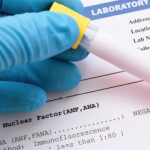ANA can also help with prognosis in juvenile idiopathic arthritis (JIA). ANA-positive JIA patients are at increased risk for uveitis. Ophthalmologic monitoring in asymptomatic ANA-positive patients helps identify and treat this devastating complication.
Are Too Many ANAs Ordered?
It is a common complaint that doctors order too many inappropriate ANA tests. However, until we improve diagnostic biomarkers, doctors may not be ordering enough ANAs in appropriate clinical settings.4 The lack of better tests is a major cause of delayed diagnoses—four to six years on average in SLE—leading to worse outcomes and prolonged suffering.4
For example, some rheumatologists feel ANAs should not be ordered in the setting of peripheral neuropathy. However, Sjögren’s disease is a commonly missed diagnosis in this setting. Therefore, the Sjögren’s Foundation Neurologic Disease Guidelines (publication pending) recommend ordering ANA in this setting. Also, autoantibodies, such as ANA and anti-SSA, often appear over a decade before SARDs, SLE for example, become symptomatic.13 Patient education and continued follow-up can lead to early diagnosis and treatment if an autoimmune disease develops in this setting.
There Is No False-Positive ANA
The finding of a positive ANA should be documented, along with its quantitative result and methodology. This should be enough to convey a sense of whether the patient could potentially have a disorder related to it. The term false-positive ANA should not be used because ANA positivity can occur during the subclinical phase of disease, many years before disease is evident.6 We cannot confidently state that an ANA is not due to a pathologic process.
ANA-Negative SLE
Around 6% of newly diagnosed SLE patients are negative for anti-cellular antibodies.14 Therefore, it is imperative not to dismiss a diagnosis of SLE in a suspected individual based on one negative ANA result.
Two separate, large, multi-center studies demonstrated the superiority of ordering ANA by both IFA and solid-phase assay to improve SLE diagnosis sensitivity.15 Patients with a SARD, including SLE, can have a positive solid-phase ANA and be negative by IFA. Therefore, clinicians should check a solid-phase ANA in IFA-negative patients suspected of SARD.
Because solid-phase assays are inexpensive, laboratories often run them as the screening test of choice. Unfortunately, up to 35% of SLE patients are ANA negative using solid-phase assays. Patients suspected of a SARD who are negative for solid-phase ANA should have it repeated by IFA.
Anti-SSA should also be ordered in ANA-negative patients suspected of having a SARD because anti-SSA can be present.16

